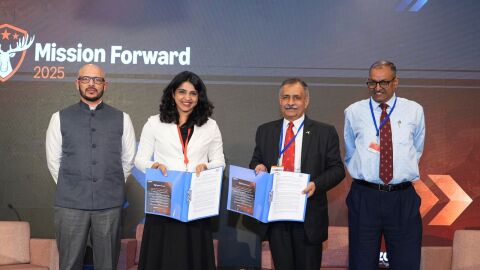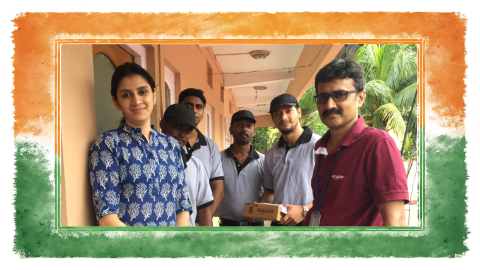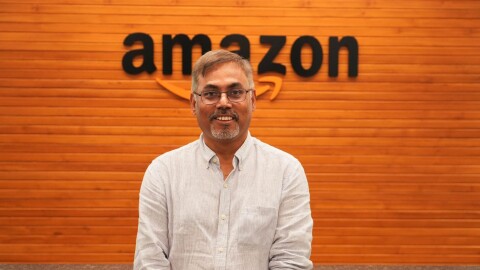In 2020, people said, “I love you,” to Alexa 19000 times a day. Accessing the voice service from over 100 smart devices, customers played music, managed to-do-lists, set alarms, controlled lights and appliances, played audiobooks, checked cricket scores and weather reports. Everything once at our fingertips is now arguably, voice controlled. So bullish are opinions that some argue, its now voice-first over mobile-first. While the verdict is yet to be out on that one, the love that Alexa has seen from India is in no doubt, as its usage increased 67% compared to the previous year.
Creating skills for a diverse customer base
Behind the soothing and ever intuitive voice of Alexa is a team, with distinct backgrounds, spearheaded by women. “When you are creating products and services for a diverse customer base, it helps to have a diverse team as well because different opinions and perspectives get represented,” said Seema Somshekar, Content Program Manager for Alexa. Agreeing with Somshekar’s opinion, Dipa Balakrishnan, senior manager for Alexa experience and engagement underlined the dangers of harbouring unidimensional decision making. “Diversity in all forms, whether related to gender, education or language is important to make sure we are not living in echo chambers, which is a risk in a social media driven world. The consequences of a singular mindset can be very narrow,” she said.
Women at the helm
Diversity in all forms, whether related to gender, education or language is important to make sure we are not living in echo chambers
Amazon nurtures its diversity and inclusion mission in a variety of ways, and Alexa has always been one of its strongholds. Women are not just represented but elevated to positions of strategic thinking and decision-making. From managing experience and engagement to natural language understanding, coding to curating, women are at the helm of every iteration. “I am responsible for integrating the power of Alexa to all third-party brands, which range from audio products like boAt and Motorola to TVs from Kevin and Shinco and, set top boxes from Dish. The role gives me the power to influence the strategy of these leading brands,” said Teena Sidana, lead for Alexa Voice Services. Sidana’s stint at Amazon spans more than 6 years. She joined as the lead for partnerships, working with banks and financial institutions to make products more affordable to customers before moving to Alexa Voice Services in 2016. In the beginning, Sidana remembers having to explain to stakeholders how voice functions. “The most meaningful challenge has been getting people to move from typing to talking and hand holding that shift in the ecosystem. We have now built a solid use case for brands. Alexa is not just an add-on feature on a device today but a must-have for new product launches” Sidana reflected. There are other perks of the job too. “I also get to build the ‘Make in India’ story and narrative with India based Original Design Manufacturers (ODMs) and System Integrators (SI) who build India-first low-cost devices,” she added.
I also get to build the ‘Make in India’ story and narrative with India based Original Design Manufacturers (ODMs) and System Integrators (SI) who build India-first low-cost devices.
Like Sidana, Somshekar too was part of the team that launched Alexa in the country. “I joined Amazon as a content editor, and I have now moved into a program management role. For someone who comes from a Journalism and Media background, with no business school or management training, it has been a great on-the-job learning experience,” she said. Somshekar had a media career of 12 years before she joined Amazon and believes that she and her team, many of whom are former journalists, views things from a different lens, which ultimately delivers a richer product or experience.
Behind the building blocks of voice innovation
In 2013, more than a year before Amazon would launch its first Echo smart speaker with Alexa, Snehal Meshram, now a Senior Manager for Alexa AI, Natural Language Understanding, Amazon India,
had applied for a program manager position. During her interview, Meshram did not know exactly what she would be working on, only that it related to Amazon’s plan to get into speech innovation. Later, she became the first employee in Alexa Machine Learning team in Sunnyvale, California. Initially, Meshram and a small team collected large amounts of data that helped bootstrap the early automatic-speech-recognition models, which supported the launch of Echo devices in late 2014. The following year, she led the data-collection initiative for Alexa Machine Learning and built a large team. Since then, she and her team iterated several large-scale data-collection efforts to support the launch of new Echo devices, features, and languages, including variants of English, German, Japanese, French, Italian, Spanish, Brazilian Portuguese and Hindi.
In mid-2018, Meshram decided she was ready for a new challenge, one that would see her return to India and focus on a new area of conversational AI — Natural Language Understanding. In this role, she again bootstrapped a multidisciplinary team of scientists, linguists, program managers and analytics experts to launch Hindi on Alexa in Sept 2019. Within a year, the impact was visible. In 2020, customers asked Alexa for Kavita over 1000 times a day and “Alexa, rasodey mein kaun tha?” more than 14000 times a day. Alexa also started serving Urdu and Love Shayari and the works of popular poets like Mirza Ghalib.
Reach out and ask for guidance when you are in doubt, don’t give in to imposter syndromes.
Meshram dreamt big, without doubt. But with dreaming big comes blood and sweat. So here is her advice on how to get through it, “I find that building multiple networking circles has helped me in times of doubt, distress and ambiguity. Reach out and ask for guidance when you are in doubt, don’t give in to imposter syndromes,” Meshram said. A strong proponent of diversity and inclusion, Meshram said her team is 37% gender diverse, with 33% diversity in tech roles and 42% female representation in leadership roles. While these figures are optimistic, the tech industry, especially when it comes to technologists is known to suffer a talent crunch; women who code are rare and there aren’t enough role models.
We have multiple internal mentorship models, focused on developing female talent in senior technology roles.
Endless possibilities with voice
Ramyaa Poosarla, senior software development engineer for Alexa, found inspiration in pioneers such as Grace Hopper. She was introduced to coding in 8th grade and converted her early passion into her profession. At the moment, Poosarla leads payments with Alexa with a vision to make these payments easy and seamless. “I get to influence the overall strategy; help define product features and drive the system architecture. I believe this will shape the future of Alexa and the scope of voice technology in the process,” Poosarla said.
After joining Amazon as a campus hire, Poosarla made her way to Alexa about 5 years later, in December 2019. “I started off as SDE1 with the Customer Returns team, which is responsible for improving the return experience on Amazon for customers globally. I worked on the backend systems responsible for execution of return resolutions. I was part of Amazon-wide goal to eliminate dependency on Relational Databases for critical services for better scalability and for my contributions to that project, I was promoted to role of SDE2,” However, the move to Alexa shifted a major post. “Until then, I was working with visual screen interfaces, which are good at revealing the possibilities with UI elements (buttons, labels and images). With voice, the possibilities are endless; there are a multitude of ways in which we want to converse with Alexa,” Poosarla said. The idea is not to overload the customer but to anticipate behavior and provide a seamless experience, she added. So much so that even those who are not comfortable with devices can make payments in a jiffy.
Poosarla agrees that in order to tip the scales in favor of female technologists, there must be internal targets related to representation, but it cannot end there. “One has to invest in leadership-oriented programs. We have multiple internal mentorship models, focused on developing female talent in senior technology roles. Technologists can participate and learn in targeted events like Grace Hopper,” she said.
When you are creating products and services for a diverse customer base, it helps to have a diverse team as well because different opinions and perspectives get represented.
To teach is to learn twice
The power of mentorship is pretty clear, better performance, career advancement and higher job satisfaction. “More than adequate representation through hiring methods, I think the one thing that I do is consciously focus on mentoring, especially women who are more junior – I see that as a way to give back the investment that people before me have made for my growth,” said Balakrishnan. Sidana credited much of her own growth within the firm to her leader who nurtured her as a new team member to becoming a team lead herself. There are also groups like Women of Alexa, which addresses critical issues. “I lean on the support group whenever I find myself in need of guidance and it offers mentorship on a range of challenges from how to deal with gender related pay gap disparities in the corporate sector to the more topical, work from home challenges one might be facing at the moment,” reflected Someshekar.











